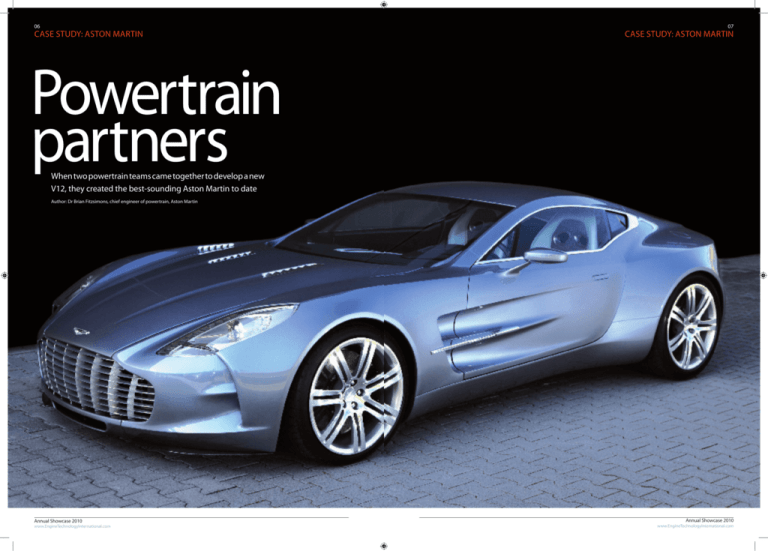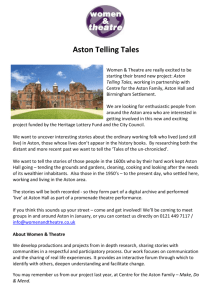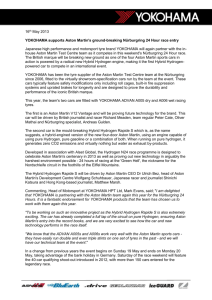Aston Martin (5) bsw.indd - Engine Technology International
advertisement

06 Case study: Aston martin 123 07 Case study: AstonHEADING Martin Powertrain partners When two powertrain teams came together to develop a new V12, they created the best-sounding Aston Martin to date Author: Dr Brian Fitzsimons, chief engineer of powertrain, Aston Martin Annual Showcase 2010 www.EngineTechnologyInternational.com Annual Showcase 2010 www.EngineTechnologyInternational.com 08 09 CAsE stuDy: AstoN mArtIN the Cosworth co-developed V12 one-77 heart generates 750bhp at 7,500rpm n the one-77 is Aston martin’s take on a definitive sports car, and one that epitomizes everything that the uK brand is about, from state-of-the-art technology to the all-new V12 and the eye-catching design. From an engineering perspective, the one-77 V12 project was an automotive engineer’s dream come true. the brief was to make Aston’s V12 engine as ‘extreme as possible but right for the road’. yet, as highly motivating as such a brief was, with management setting tough targets for the powertrain team to meet, it posed serious engineering and technical challenges for the powertrain engineers, as highlighted in tables 1 and 2. there were, however, some unquantifiable targets during the project, as shown in tables 1 and 2. terminology such as ‘more than’ and ‘less than’ was used to encourage the engineering team not to stop when the engineering target was achieved, taking the V12 and the one-77 beyond the project’s set goals. As an independent sports-car manufacturer, Aston martin is free from any corporate prejudice or skill-set bias that can build up in an enginedesign function over time. this gave the engineering team tremendous freedom to select the best skilled partner to deliver the new V12. It was judged that Cosworth had the 0-60mph 0-100mph top speed Vehicle mass Cd Power/weight Weight/power operating environment under 4 secs under 7 secs more than 200mph less than 1,500kg less than 0.4 more than 450Ps/t less than 2.3kg/Ps -15°C to +50°C table 1: Aston martin’s initial vehicle target for the one-77 development project Power output torque output specification Installation range NVH more than 700bhp more than 700Nm naturally aspirated V12 engine as low and rearward as possible more than 300 miles the best-sounding Aston martin table 2: Aston martin’s initial engine target for the one-77 development project swept-volume increase Bore increase stroke increase maximum power speed maximum mechanical engine speed increase F1-derived dry-sump lubrication system New port design built upon F1 experience Variable valve timing on intake 5,935cm3 to 7,312cm3 89mm to 94mm 79.5mm to 87.8mm 7,500 rev/min 7,300 to 7,750 rev/min table 3: Early simulation modeling results of Aston martin’s one-77 V12 powertrain Annual showcase 2010 www.EnginetechnologyInternational.com CAsE stuDy: AstoN mArtIN the 7.3-liter powertrain will sit 257mm further rearward of the one-77 front axle “Itwasjudgedthat Cosworthhadthe best skill set and experience that wouldcomplement theAstonmartin engineeringteam” best skill set and experience that would complement the Aston martin powertrain engineering team, possessed experience of delivering production engine designs and components, and understood Aston martin’s manufacturing and qualityprocess functions. thus Cosworth, which had previously delivered the Vanquish s cylinder-head design, was selected as the engine-design partner for the V12 project. the benefit of a good team cannot be underestimated, because it is that team – and not technologies such as the best CAD and analysis packages – that delivers the engine. the team was led by Aston martin’s Chris Porritt as the project manager, with design direction coming from Cosworth’s Bruce Wood. Integration into the one77 was led by Aston martin’s richard morley, with a joint team of module owners, designers and development engineers. Engine and vehicle calibration was performed by the Aston martin calibration team, led by John mcLean. Engine specification It was clear from the start of the one-77 program that the basis of the engine was to be the 6-liter V12 that powers both the DBs and V12 Vantage models. this engine has a fantastic track record but perhaps even more importantly, it had considerable development potential. therefore the team set out to maintain as much of the original architecture as possible and only change features that enabled them to ‘make the V12 as extreme as possible but right for the road’. the usual first step with such a project was using 1D simulation to design the primary engine parameters to meet the performance targets. Because the basis of this engine was to be the Aston martin V12, there was a considerable amount of already-validated data, so a good level of confidence existed in the model from the beginning. the opportunity was the brief to examine considerably more extreme design options for this unique application. the modeling results led to the primary engine specification in table 3, and this gave a power and torque curve that appreciablyexceededthetargets – a good position to be in at the start of the design process! Engine features Each major design decision was analyzed and evaluated using Above and right: the V12 features four throttle bodies – two on each bank – which are symmetrically arranged experimental data, analysis data, surrogate data, and experience. Naturally, the most difficult to quantify was experience, but it was a priceless input to the design process. Each design decision was evaluated for impact on performance, friction, package, mass, aesthetics, emissions output and cost. one of the most critical systems in achieving the initial performance target was the intake system. It was here that meticulous attention to detail yielded very good results. At the heart of the one-77 engine was an F1-derived port design that specifically targets flow velocity at 7,500 rev/min. the shape of the port gives this subsystem a free-flowing path to the combustion chamber. the ports and combustion chamber were fully machined, enabling them to be accurately manufactured, free from defects that might disturb the ideal function, and repeatability. the actuation of 12mm intake and 11mm exhaust valves was by lightweight, direct-acting buckets coated with DLC giving ultra low friction at high speed. Analysis and experiment showed that roller-finger followers would have lower friction at lower engine speed where cycle fuel economy is important, but this engine focused on lower friction at the high-power end. meticulous attention was paid to the air intake subsystem to ensure V12 met performance goals the volume in the intake manifold plenums around the induction trumpets was maximized to allow good airflow and take full benefit of the gas dynamic tuning. this led to a bigger and heavier intake manifold but to counteract this, the plenums were manufactured in lightweight carbon fiber. Four throttle bodies were used, two on each bank, symmetrically arranged. this enabled optimal flow distribution and maximized the V12’s sound quality. Cylinder block and crankcase the cylinder block has retained the original architecture bore spacing of 102mm but the bore has been increased to 94mm. replacing the original pressed-in cast-iron liners, the bore has been plasmairon sprayed onto the parent metal, using the sulzer metco rotaPlasma process. this has given a weight saving, improved the cooling performance, and increased the engine knock resistance. the block casting was modified slightly to accommodate the increase in stroke from 79.5mm to 87.8mm. this manufacturing process continued to use the DBs engine CosCast process – a pressurized sand-cast process, developed by Cosworth. In addition, the casting was subject to the hot isostatic process to give improved fatigue properties, with the increased engine performance. on the bottom end, the cast-iron main bearing caps were replaced with aluminum for mass reduction and redesigned to seal the chambers for the dry-sump system. the original crossbolting structure was retained. the eight-counterweight crankshaft setup was replaced with a 12-counterweight design. A forged-steel V12 crankshaft is a considerable proportion of the engine mass. However, extensive design analysis resulted in a fully optimized 12web crankshaft that, despite increases in both stroke and engine speed, yielded a saving of 1.4kg in mass. original bearing pin diameters were retained and to increase fatigue life, design changes were made to the fillet radii on the big-end pins. the crankshaft web radius was machined to match piston motion and minimize clearance to minimize engine height. Piston-guidedsteelconnecting rods were used rather than the crank-guided rods that feature in the Aston DBs engine. this change reduced friction levels and gave a 1.2% power gain. the piston-guided steel connecting rods also reduced connecting-rod mass. the pistons were entirely new and constructed from a bespoke forging with a 32mm skirt Annual showcase 2010 www.EnginetechnologyInternational.com 10 CAsE stuDy: AstoN mArtIN length. FEA and race experience was used to optimize the piston design for minimum mass, resulting in a mass reduction of 24g over the original assembly, despite being considerably more loaded. the piston pins were DLC coated to further reduce friction levels, and the standard oil-cooling jets were retained. the packaging challenge the packaging of a 7.3-liter V12 unit in a front-engined sports car is a considerable challenge. Engine performance dictated that the intake system should not suffer any compromises due to the package. the key enabler to achieve this was the new drysump system. there was considerable experience and expertise coming from the Aston martin V8 Vantage application, as well as Cosworth’s F1 and WrC projects. the result was a drysump system that enabled the engine to sit 100mm lower in one-77 than in any of its other Aston martin applications. this produced a 16.5mm clearance from the intake system to the body, at the top of the engine. the key features of the drysump system are fully sealed bays in the oil pan, each of which are scavenged by a separate scavenge pump with a scavenge ratio of 4:1. the scavenge pumps feed the oil Engine weight was high on the development agenda. As a result, the V12 tips the scales at just 260kg Annual showcase 2010 www.EnginetechnologyInternational.com “Piston-guidedsteel connecting rods wereusedrather than the crankguided rods that featureinAstonDBs” tank via a swirl pot, and thereafter, a de-aeration plate. the oil is then picked up by the oil-pressure pump, which retains the original V12 oilpump internals, but in a bespoke housing to facilitate a chain drive for the scavenge pumps. the installation process was difficult; other major achievements included maintaining the same oil volume as the standard wet sump-system V12, and achieving aeration of only 7%. Above: Am says some 80% of parts on the one-77 engine are new Below: the lightweight cam cover Exhaust system the one-77’s exhaust system provided a major packaging challenge, because the engine position was too low for the exhaust to pass below the bell housing. making things all the more challenging was the Euro 5 emissions target, the 700bhp, and the one-77’s carbon-fiber construction. the only solution was to route the exhaust manifold out to the side of the car and along the sills. the next hurdle was to define the best compromise between engine performance and emissions. two scenarios were evaluated and both of these designs had equal length primary pipes with good catalyst inlet conditions, which represented a considerable geometrical achievement. Performance evaluation of the exhaust manifolds were outlined in the development project and this is a good example of where the final decision was not in favor of the higher power output. Instead, a shorter primary system was selected because of its emissions potential, and the compromise on performance was quantified, understood, and accepted. Induction system A high-performance sports car needs to have a very efficient air path. the solution was a very elegant one. the front longitudinal structure in carbon fiber was designed to perform three functions without compromise: provide the air path, be a structural crash member, and provide mounting for the front fender. this helped provide an efficient, high volumetric-flow path to the quad throttles located mid-car from the twin airboxes at the front, and demonstrated the integrated functionality that was critical to achieving the best result for one-77. such developments, as well as attention to detail, allowed for all targets to be met. more than 700bhp and more than 700Nm of torque was achieved, the engine was positioned as low and rearward as possible, and it is the best-sounding Aston martin to date. Eti





